As technology evolves and the emphasis on non-invasive cosmetic procedures continues to grow, laser skin tightening has emerged as one of the most sought-after treatments for improving skin laxity and texture. For individuals seeking a non-surgical path to smoother, firmer skin, laser-based therapies offer a clinically backed solution that spans the entire body—from the delicate skin of the neck to the more resilient tissues of the abdomen and arms. But what exactly should one expect from these procedures? And how do the results compare across various areas such as the neck, stomach, and arms? This comprehensive guide demystifies laser skin tightening procedures while grounding the conversation in medical accuracy, aesthetic science, and lived patient experience.
You may also like: How to Tighten Loose Skin After Weight Loss: Science-Backed Strategies for a Firmer, Healthier You
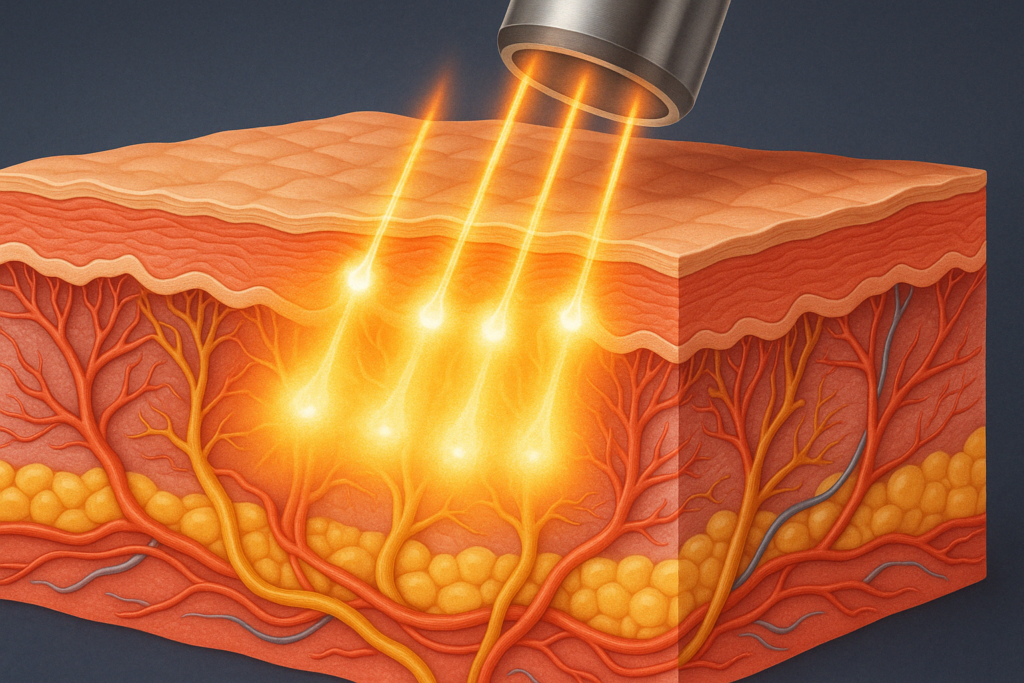
Understanding the Science Behind Laser Skin Tightening
At the heart of every laser skin tightening procedure is the principle of controlled thermal injury. Through targeted light energy, lasers penetrate beneath the skin’s surface, stimulating collagen and elastin production without damaging the outer layers. Collagen is a structural protein critical for maintaining skin firmness, while elastin ensures skin retains its shape after stretching. By promoting neocollagenesis—the production of new collagen—laser devices create a natural rejuvenation process that enhances skin texture and reduces sagging over time.
The choice of laser technology depends on the treatment area and the specific aesthetic goals. Devices such as Nd:YAG, CO2, and radiofrequency-assisted lasers are among the most commonly used. These lasers differ in wavelength, depth of penetration, and thermal diffusion, allowing clinicians to tailor treatments based on the thickness of the skin and the severity of laxity. As with any medical-grade intervention, the efficacy of laser skin tightening hinges on clinical experience, patient-specific protocols, and realistic expectations.

Neck Tightening Laser Treatments: Delicate Area, Powerful Results
The skin on the neck is notoriously thin and more prone to early signs of aging. Because of its delicate nature, treating this area requires specialized technology and expertise. Neck tightening laser procedures typically utilize lower-energy settings or fractional devices that provide precise, targeted energy without overstimulating or damaging the sensitive skin. A well-performed laser treatment for neck tightening can improve texture, minimize fine lines, and restore a firmer contour to the jawline.
Patients often seek neck firming laser therapy as an alternative to surgical neck lifts. While the results are not identical, laser options offer a compelling choice for those seeking moderate tightening without incisions or downtime. It’s important to note that collagen remodeling is gradual. Most individuals observe optimal outcomes three to six months after their final session, as the skin continues to rebuild its internal support structure. For individuals researching laser treatment to tighten neck skin or exploring laser treatment for crepey neck skin, understanding the timeline and cumulative benefits is crucial.
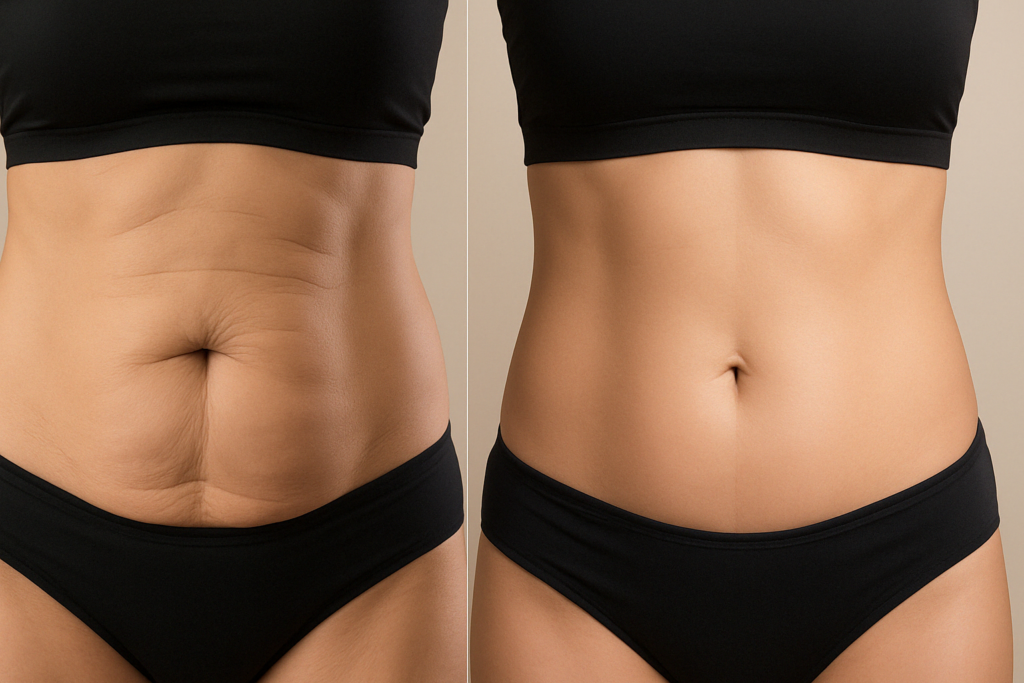
Laser Skin Tightening for the Abdomen: What Before and After Images Reveal
Among all areas, the abdomen is one of the most commonly requested regions for laser skin tightening. Pregnancy, weight fluctuations, and aging can all lead to laxity in this area. Patients exploring laser skin tightening abdomen before and after results often do so with the hope of reversing mild to moderate sagging and achieving a more toned appearance without surgery.
Laser treatment to tighten stomach skin generally requires multiple sessions to produce visible improvement, especially in cases of postpartum skin stretching or early signs of aging. The abdomen has thicker dermal layers than the neck or face, making it suitable for more aggressive modalities such as CO2 lasers or combined radiofrequency devices. For optimal outcomes, a tailored approach is essential. Providers often recommend spacing sessions about four to six weeks apart to allow the skin adequate time for healing and collagen regeneration.
Before and after photos can offer a helpful visual guide, but expectations must be rooted in clinical reality. Laser therapy is not a substitute for abdominoplasty when excess skin is significant, but it is highly effective for tightening mild to moderate laxity. Furthermore, the best laser for skin tightening on the stomach varies depending on factors such as skin type, pigment, and underlying muscle tone. This variability highlights the importance of consultation with a qualified professional.
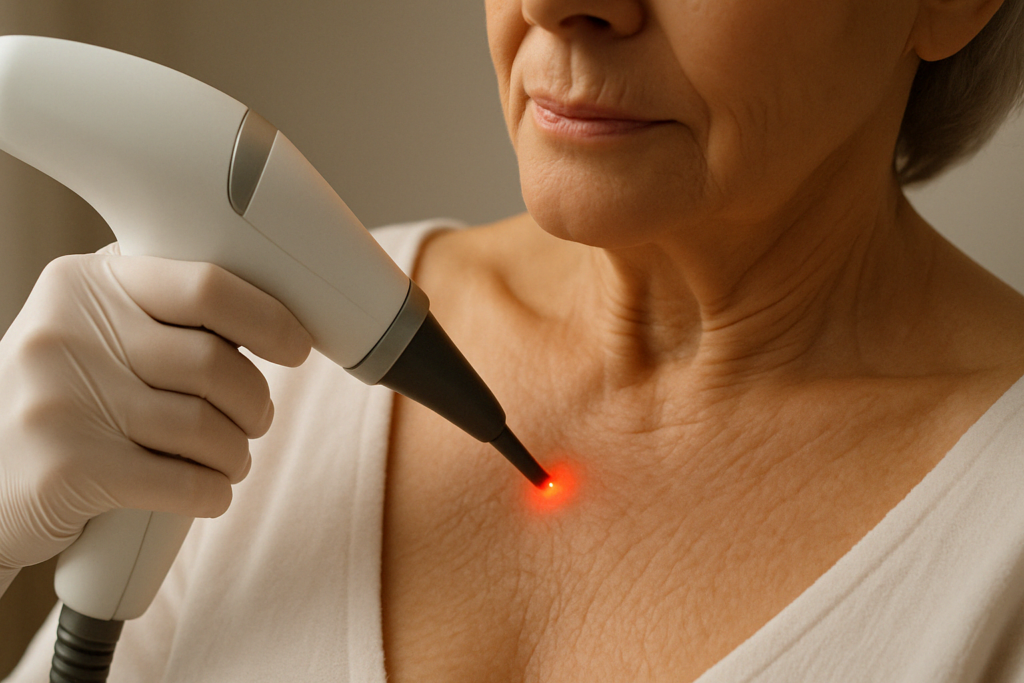
Laser for Crepey Skin: A Transformative Option for Texture Improvement
Crepey skin, characterized by a thin, wrinkled texture resembling crepe paper, often results from a combination of sun damage, collagen loss, and intrinsic aging. While it can appear anywhere, it is particularly common on the neck, chest, inner arms, and above the knees. The appeal of using laser for crepey skin lies in its ability to stimulate dermal remodeling while preserving the skin’s surface integrity.
Laser treatment for crepey skin often employs fractional devices that deliver microthermal zones of energy to specific depths within the skin. This method not only jumpstarts collagen production but also allows for quicker healing and less downtime than fully ablative lasers. For patients who are hesitant about surgery or chemical peels, laser treatment provides a more controlled, predictable path to improvement.
In areas where crepiness is most prominent, such as the neck, a combination of neck firming laser therapy and fractional resurfacing can lead to substantial enhancements in skin quality. While patients may require multiple sessions, the cumulative results tend to be long-lasting when paired with diligent skincare and sun protection. For those considering laser treatment for crepey neck skin, realistic expectations and a personalized regimen are key components of success.
Does Laser Skin Tightening Work? Evaluating Evidence and Outcomes
One of the most frequently asked questions surrounding this technology is straightforward: does laser skin tightening work? The short answer, backed by peer-reviewed studies and clinical observations, is yes—when performed correctly and on appropriate candidates. The degree of improvement depends on multiple factors, including age, baseline skin condition, device type, and adherence to post-treatment care.
Clinical data has shown that patients typically see a 10% to 30% improvement in skin laxity after a full treatment series. While this may sound modest, for individuals with early to moderate signs of aging, this degree of tightening can translate into a significantly more youthful appearance. Moreover, laser surgery to tighten skin offers the benefit of minimal downtime and a low risk profile, especially compared to surgical alternatives.
The credibility of the practitioner and the customization of the treatment plan significantly influence outcomes. Skilled providers not only select the appropriate laser modality but also calibrate energy levels, session intervals, and treatment depths based on individual anatomy. This personalized approach enhances results while reducing the likelihood of adverse effects. For patients evaluating whether laser treatment is worth the investment, it is crucial to understand that results are progressive and best appreciated over several months.
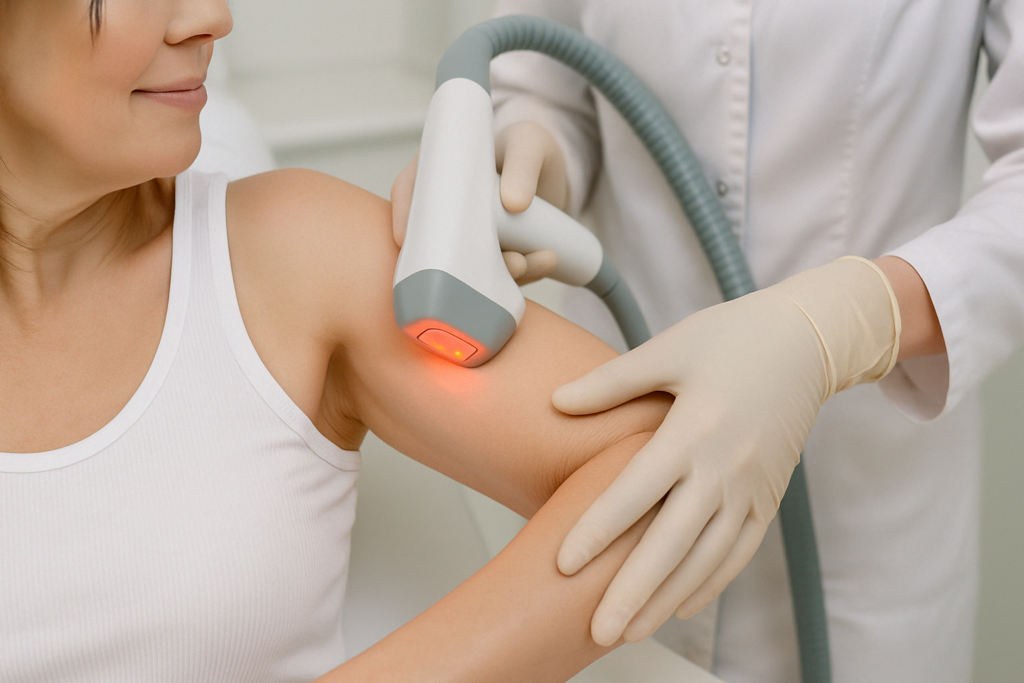
What to Expect from Laser Skin Tightening Arms Treatments
While the arms may not always be the first area people think of when considering skin tightening procedures, they are frequently a source of concern—particularly in individuals experiencing age-related laxity or post-weight loss sagging. Laser skin tightening arms treatments address these issues by targeting the underlying dermal structures that contribute to firmness.
Because the skin on the upper arms is often thicker and more resistant than on the neck or face, treatments here typically utilize higher-intensity lasers or those designed to penetrate deeper layers. Some practitioners may also combine laser therapy with microneedling or radiofrequency to maximize collagen synthesis. This synergistic approach is especially effective in addressing crepey texture and improving overall tone.
Patients should anticipate gradual improvements, with the best results emerging several weeks after the final session. Adherence to post-treatment care, including hydration, sun protection, and the use of topical collagen-supporting products, can significantly extend the benefits. For individuals frustrated by the appearance of loose or crepey skin on the arms, laser therapy presents a practical and scientifically validated solution.
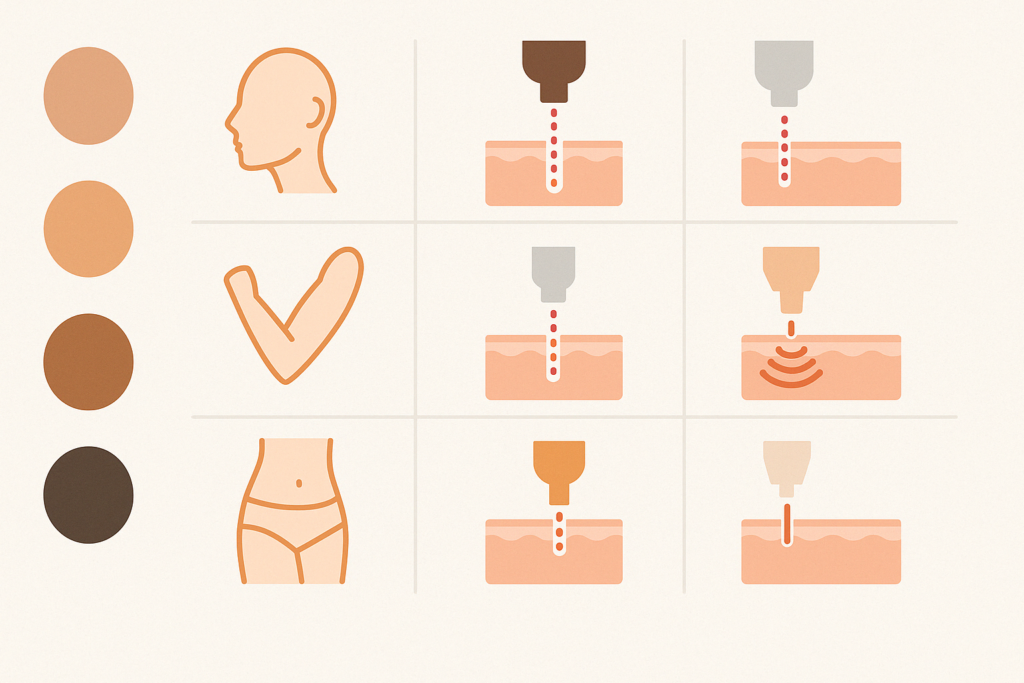
Tailoring Treatments: Matching Devices to Skin Types and Goals
Not all lasers are created equal, and not all skin responds the same way. Customization is fundamental to the success of any laser skin tightening procedure. Variables such as Fitzpatrick skin type, degree of laxity, presence of pigmentation issues, and individual healing responses all play a role in shaping the treatment protocol. For example, individuals with darker skin tones may benefit more from radiofrequency-based lasers, which pose a lower risk of hyperpigmentation.
A skilled practitioner will conduct a thorough assessment, including medical history and aesthetic goals, before recommending a treatment plan. This ensures that each session is not only effective but also safe. For those exploring a body skin tightening laser, it’s essential to understand that outcomes depend not just on the technology itself but also on its thoughtful application.
The ability to treat multiple body regions—from the arms and abdomen to the neck—makes laser skin tightening a flexible tool in the aesthetic toolkit. Yet the success of these procedures rests heavily on precision, preparation, and professional oversight. Matching the right device and settings to the individual’s anatomy is what turns a good result into a great one.
Combining Laser Treatments with Lifestyle for Lasting Results
While laser therapy can produce remarkable improvements in skin firmness and texture, long-term results are most sustainable when supported by healthy lifestyle choices. Nutrition, hydration, sleep quality, and sun exposure all directly impact the skin’s regenerative capacity. Antioxidant-rich diets, adequate protein intake, and omega-3 fatty acids support collagen synthesis at the cellular level.
Topical skincare also plays a critical role. Using products that contain retinoids, peptides, and hyaluronic acid can enhance the effects of laser treatments by maintaining skin hydration and promoting ongoing collagen remodeling. Additionally, wearing broad-spectrum sunscreen daily is perhaps the single most effective measure for preserving the results of any laser procedure.
For individuals looking to maximize their investment in laser skin tightening procedures, this holistic approach cannot be overstated. The synergy between advanced technology and disciplined self-care often determines the longevity and quality of the final outcome. Patients who follow post-treatment protocols and adopt skin-supportive habits tend to enjoy firmer, smoother skin well beyond the initial treatment window.
Reflecting on the Future: The Expanding Role of Laser Skin Tightening in Health and Wellness
Laser skin tightening has transcended its origins as a purely cosmetic intervention. Increasingly, it is being embraced within broader conversations about health, self-esteem, and mental wellness. For many patients, improving the appearance of sagging skin is not merely an aesthetic decision but a form of reclaiming confidence and agency over one’s body.
This psychological dimension aligns seamlessly with the values of holistic wellness. Procedures that help individuals feel more aligned with their internal and external identities often contribute to greater emotional resilience, self-perception, and quality of life. For patients navigating aging, post-pregnancy body changes, or weight loss transformations, the ability to improve skin tone through minimally invasive means can be profoundly empowering.
As technologies continue to advance, we can anticipate even more refined tools for targeting skin laxity with precision and safety. Innovations such as AI-guided laser calibration, combination protocols, and biomarker-driven personalization are already in development, promising a future in which treatments are not only more effective but also more attuned to individual needs.
Laser Skin Tightening FAQ: Advanced Insights on Neck, Abdomen, Arms, and More
1. Can laser skin tightening procedures target multiple areas in one session, like the neck and abdomen?
Yes, laser skin tightening procedures can often be performed on multiple areas during a single session, depending on the patient’s skin condition and the type of device used. For instance, a practitioner may combine a neck tightening laser protocol with a body skin tightening laser session focused on the abdomen. While this combined approach can be efficient, it does require more intensive pre-treatment planning to ensure energy levels and device settings are safe and effective for each area. For patients considering laser treatment for crepey neck skin alongside laser treatment to tighten stomach skin, managing downtime, hydration, and skin sensitivity post-session is crucial. It’s also important to remember that treating multiple areas may extend the session duration and may slightly increase the recovery period due to the greater skin surface being treated.
2. How do hormonal changes impact the effectiveness of neck firming laser treatments?
Hormonal fluctuations, especially those related to menopause or thyroid dysfunction, can significantly influence the skin’s elasticity and collagen production. When estrogen levels drop, for example, the skin tends to become thinner and more prone to sagging. This can affect how the skin responds to laser treatment for neck tightening, potentially requiring more sessions or longer recovery times. For individuals undergoing neck firming laser therapy during times of hormonal change, supportive care like bioidentical hormone therapy or collagen-boosting supplements may enhance results. Understanding these physiological dynamics helps ensure that neck tightening laser procedures are timed and tailored appropriately for optimal success.
3. Are there specific protocols for post-pregnancy patients seeking laser treatment to tighten stomach skin?
Yes, postpartum individuals often benefit from specially adapted protocols when pursuing laser treatment to tighten stomach skin. Skin in the abdominal area post-pregnancy can be both stretched and hormonally altered, which affects collagen responsiveness. The best laser for skin tightening on the stomach in such cases usually involves a combination of fractional CO2 or radiofrequency lasers that penetrate deeply without extensive surface damage. Additionally, postnatal patients should wait at least six months after childbirth before starting laser skin tightening abdomen before and after treatments to allow hormonal balance to stabilize. Combining therapy with core-strengthening exercises and topical skincare products can further support recovery and improve skin tone.
4. How does a body skin tightening laser differ in approach when used on arms versus the stomach?
Laser skin tightening arms treatments typically require a different energy delivery method than those used for the abdomen. The skin on the arms is often more fibrous and thinner, especially on the inner biceps, which calls for more precise energy modulation. By contrast, when using a body skin tightening laser on the stomach, practitioners often employ deeper-penetrating devices to address the thicker dermal layers. To maintain safety and avoid burns or uneven results, technicians must customize handpiece size, pulse duration, and cooling techniques for each area. This is especially relevant for patients undergoing both laser treatment to tighten stomach skin and laser skin tightening arms in a combined regimen.
5. What role does skin phototype play in selecting the best laser for skin tightening on the stomach or other areas?
Skin phototype—the classification of skin based on its reaction to UV exposure—greatly influences laser choice and intensity. For darker skin tones (Fitzpatrick types IV-VI), there is an increased risk of hyperpigmentation and post-inflammatory darkening, particularly when using aggressive lasers. In these cases, non-ablative options or radiofrequency-based devices are preferred for procedures like laser treatment to tighten stomach skin or laser treatment for crepey skin. Lighter skin tones typically tolerate more intense fractional lasers, which are often considered the best laser for skin tightening on stomach regions with moderate laxity. Customizing protocols based on skin phototype ensures efficacy while minimizing complications.
6. Is there a difference between laser surgery to tighten skin and non-surgical laser treatments?
Yes, while both fall under the umbrella of laser skin tightening procedures, there’s a notable distinction between non-surgical laser therapy and laser surgery to tighten skin. The latter often refers to more ablative, invasive laser technologies—such as deep CO2 resurfacing—that may require anesthesia and longer recovery. Non-surgical procedures like neck tightening laser therapy or laser skin tightening arms treatments generally use non-ablative devices that offer minimal downtime and lower risk. Laser surgery to tighten skin is typically reserved for more advanced cases of skin laxity or when dramatic results are desired quickly. Understanding the spectrum of laser options helps patients make informed choices based on downtime tolerance and treatment goals.
7. What are the most common mistakes patients make after laser skin tightening abdomen before and after sessions?
A frequent mistake is failing to adhere strictly to post-treatment care instructions, especially regarding sun exposure and hydration. After laser treatment to tighten stomach skin, the epidermis is more vulnerable to UV rays and environmental stressors, which can delay healing and reduce collagen remodeling. Another common issue is impatience—some patients expect immediate transformation and may prematurely seek additional treatments, which can lead to overtreatment or inflammation. Additionally, neglecting proper nutrition and skipping follow-up visits can compromise the long-term benefits shown in laser skin tightening abdomen before and after comparisons. Educating patients about realistic timelines and lifestyle factors is key to sustaining visible results.
8. Can laser treatment for crepey skin be combined with injectables or fillers?
Absolutely. In fact, combining laser treatment for crepey skin with dermal fillers or biostimulatory injectables like Sculptra can significantly enhance outcomes. While the laser works to improve the skin’s surface and stimulate collagen, fillers restore lost volume that contributes to the crepey appearance. This is particularly effective in areas like the upper arms and décolletage, where both volume loss and thinning skin contribute to visible aging. Laser treatment for crepey neck skin may also be paired with neuromodulators like Botox to soften platysmal bands and further rejuvenate the neck. A combination approach, guided by a skilled practitioner, allows for a more comprehensive aesthetic transformation.
9. What future technologies are emerging in the realm of laser skin tightening arms and full-body procedures?
Several cutting-edge innovations are emerging to improve precision, safety, and personalization in body skin tightening laser applications. AI-powered laser devices are being developed to automatically adjust pulse depth and energy based on real-time feedback from the skin. These are especially promising for laser skin tightening arms, where skin density and muscle proximity vary widely. There’s also growing interest in hybrid technologies that combine ultrasound, laser, and radiofrequency in one device to maximize collagen remodeling. For full-body treatments—including laser treatment to tighten neck skin and stomach skin—new handpieces with dynamic cooling systems and improved skin mapping software are reducing treatment times and improving comfort. These developments point toward a future of more effective and individualized laser skin tightening procedures.
10. How can mental wellness benefit from consistent use of laser skin tightening procedures?
While primarily aesthetic in purpose, procedures like neck firming laser treatments and laser skin tightening arms therapy can contribute meaningfully to mental well-being. Many patients report improvements in self-image and confidence after addressing skin concerns that previously caused social discomfort or anxiety. These emotional benefits can be especially profound for individuals recovering from significant life transitions—such as childbirth, weight loss, or illness—where body image may have been impacted. Consistency in maintaining results, such as scheduling follow-up sessions and integrating at-home skincare, can also foster a sense of control and self-care. Thus, while laser treatment for crepey skin and other laxity concerns addresses the surface, it often supports deeper emotional resilience and empowerment.
Conclusion: From Confidence to Collagen—Why Laser Skin Tightening Procedures Offer More Than Aesthetic Benefits
In the evolving landscape of health and wellness, laser skin tightening procedures occupy a unique and increasingly vital role. These treatments, spanning from neck firming laser options to comprehensive body skin tightening laser therapies, offer more than just visible results. They represent a fusion of scientific precision, personalized care, and holistic wellbeing.
Whether one is considering laser treatment to tighten stomach skin, exploring laser skin tightening arms therapy, or seeking a solution for crepey skin on the neck, the journey toward firmer skin is also a journey toward renewed confidence. The effectiveness of these procedures—evidenced in countless laser skin tightening abdomen before and after transformations—underscores their credibility and relevance in both medical aesthetics and self-care.
Ultimately, the answer to “does laser skin tightening work?” lies not just in clinical trials or photographs, but in the lived experiences of those who undergo these treatments with realistic expectations and trusted professionals. With thoughtful planning, expert guidance, and consistent post-treatment care, laser skin tightening offers a pathway to not just improved skin, but improved self-perception. In doing so, it supports both outer radiance and inner resilience—a goal that resonates deeply across all dimensions of health.
Was this article helpful? Don’t let it stop with you. Share it right now with someone who needs to see it—whether it’s a friend, a colleague, or your whole network. And if staying ahead on this topic matters to you, subscribe to this publication for the most up-to-date information. You’ll get the latest insights delivered straight to you—no searching, no missing out
Further Reading:
Laser Skin Tightening: What to Expect, Procedure, Results
How Laser Skin Tightening Works: Benefits and Results
Laser Skin Tightening – How to Prepare and What to Expect
Disclaimer
The information contained in this article is provided for general informational purposes only and is not intended to serve as medical, legal, or professional advice. While Health11News strives to present accurate, up-to-date, and reliable content, no warranty or guarantee, expressed or implied, is made regarding the completeness, accuracy, or adequacy of the information provided. Readers are strongly advised to seek the guidance of a qualified healthcare provider or other relevant professionals before acting on any information contained in this article. Health11News, its authors, editors, and contributors expressly disclaim any liability for any damages, losses, or consequences arising directly or indirectly from the use, interpretation, or reliance on any information presented herein. The views and opinions expressed in this article are those of the author(s) and do not necessarily reflect the official policies or positions of Health11News.